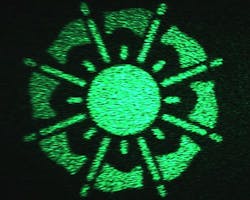Researchers at the Harvard John A. Paulson School of Engineering and Applied Sciences at Harvard University (Cambridge, MA) have programmed polarization into compact holograms. These holograms use nanostructures that are sensitive to polarization (the direction in which light vibrates) to produce different images depending on the polarization of incident light. This advancement, which works across the spectrum of light, improves anti-fraud holograms as well as those used in entertainment displays.
RELATED ARTICLE: 'Tamper-proof' anticounterfeit hologram is sculpted by UV laser directly into metal
"The novelty in this research is that by using nanotechnology, we've made holograms that are highly efficient, meaning that very little light is lost to create the image," said Federico Capasso, the Robert L. Wallace Professor of Applied Physics and Vinton Hayes Senior Research Fellow in Electrical Engineering and senior author of the paper. "By using incident polarized light, you can see far a crisper image and can store and retrieve more images. Polarization adds another dimension to holograms that can be used to protect against counterfeiting and in applications like displays."
Harvard's Office of Technology Development has filed patents on this and related technologies and is actively pursuing commercial opportunities. The research is described in Science Advances.
Holograms, like digital photographs, capture a field of light around an object and encode it on a chip. However, photographs only record the intensity of light while holograms also capture the phase of light, which is why holograms appear three-dimensional. "Our holograms work like any other but the image produced depends on the polarization state of the illuminating light, providing an extra degree of freedom in design for versatile applications," said Mohammadreza Khorasaninejad, postdoctoral fellow in the Capasso Lab and first author of the paper.
The team built silicon nanostructured patterns on a glass substrate that act as superpixels. Each superpixel responds to a certain polarization state of the incident light. Even more information can be encoded in the hologram by designing and arranging the nanofins to respond differently to the chirality of the polarized incident light. "Being able to encode chirality can have important applications in information security such as anti-counterfeiting," said Antonio Ambrosio, a research scientist in the Capasso Lab and co-first author. "For example, chiral holograms can be made to display a sequence of certain images only when illuminated with light of specific polarization not known to the forger."
"By using different nanofin designs in the future, one could store and retrieve far more images by employing light with many states of polarization," said Capasso. And because this system is compact, it has application in portable projectors, 3D movies, and wearable optics.
"Modern polarization imaging systems require cascading several optical components such as beam splitters, polarizers and wave plates," said Ambrosio. "Our metasurface can distinguish between incident polarization using a single layer dielectric surface."
"We have also incorporated in some of the holograms a lens function that has allowed us to produce images at large angles," said Khorasaninejad. "This functionality combined with the small footprint and lightweight, has significant potential for wearable optics applications."
This work was supported in part by the Air Force Office of Scientific Research, Google, and Thorlabs.
SOURCE: Harvard University; http://www.seas.harvard.edu/news/2016/05/technique-makes-holograms-highly-efficient-secure

